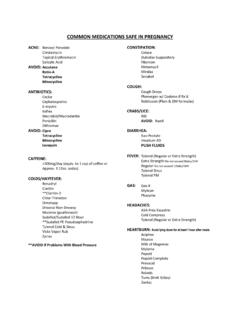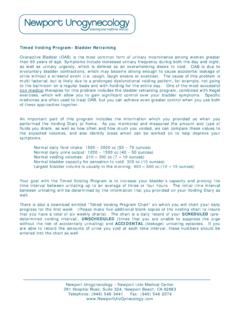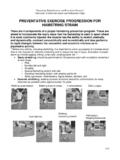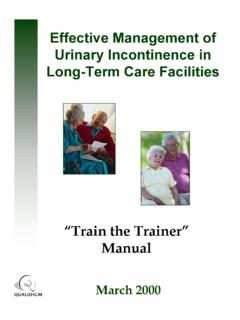Transcription of Kegel Exercises - Gynecologists
1 The Female PatientThe muscles that surround the vagina called the pelvic floor muscles (PFM) help to support the pelvic organs. Weakening of the PFM often results in loss of urine when laughing, coughing, sneezing, exercising, or rising from a chair. Exercises to strengthen the PFM were popular-ized by Dr Arnold Kegel , and are often called Kegel Exercises . These Exercises can help to con-trol urinary incontinence and these Exercises by emptying your blad-der. Lie down with your head slightly elevated (at a 20 angle) and your knees bent comfort-ably. Try to relax completely. To aid in achiev-ing a relaxed state, try repeating this relaxation technique: First, tense your fist into a tight ball and count to five. Then, completely relax your fist. Can you feel the difference between the two states? It is important that you are able to do so. Now, contract your abdominal muscles tightly for a few seconds; then relax them completely.
2 This is the way your stomach muscles should feel when you do Kegel Exercises : to think about the area around your vagina. You want to draw the muscles together quickly and deliberately as though you were trying to stop urination or a bowel movement. Once you have pulled the muscles together, hold the con-traction for 10 seconds; then relax completely. Let approximately 10 seconds elapse before beginning another Kegel you contract or tighten your pelvic mus-cles, you may note that these muscles tire easily, or that you are not able to hold the contraction for the entire 10 seconds. As you continue to exercise , this will happen less frequently. If you think that you are no longer tightening or con-tracting your muscles , it is very important that you do not tighten them to see if you are con-tracting. The goal is to maintain constant effort in an active squeeze to build muscle control.
3 In fact, it is more important to maintain a strong, active squeeze for a shorter period of time than to keep flicking the muscle for 10 seconds. You may need to work up gradually to a full 10-second the following example of Kegel exercise , to the count of 10 seconds: 1. Contract the muscles around the vagina deliberately, quickly, and hard 2. Hold it 3. Hold it 4. Hold it 5. Hold it 6. Hold it 7. Hold it 8. Hold it 9. Hold it10. Relax the program by exercis-ing three times per day, starting with 10 contractions each time (30 contractions per day). Each week, add five contractions to your regimen until you reach 20 contractions, three times a day, (60 per day). Try to do the Exercises at a set time each day, preferably when you are not too tired. When you get comfortable doing the Exercises laying down, you may do them patient handout was provided by Dorothy Kammerer-Doak, MD, associate clinical professor, Department of Obstetrics and Gynecology, University of New Mexico, Albuquerque; and urogy-necologist, Lovelace Health Systems, Albuquerque, Exercises3/07 The Female Patient grants permission to reproduce this handout for the purposes of patient HandoutTo aid in achieving a relaxed state, try repeating this relaxation technique: First, tense your fist into a tight ball and count to five.








